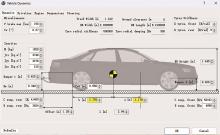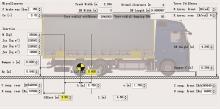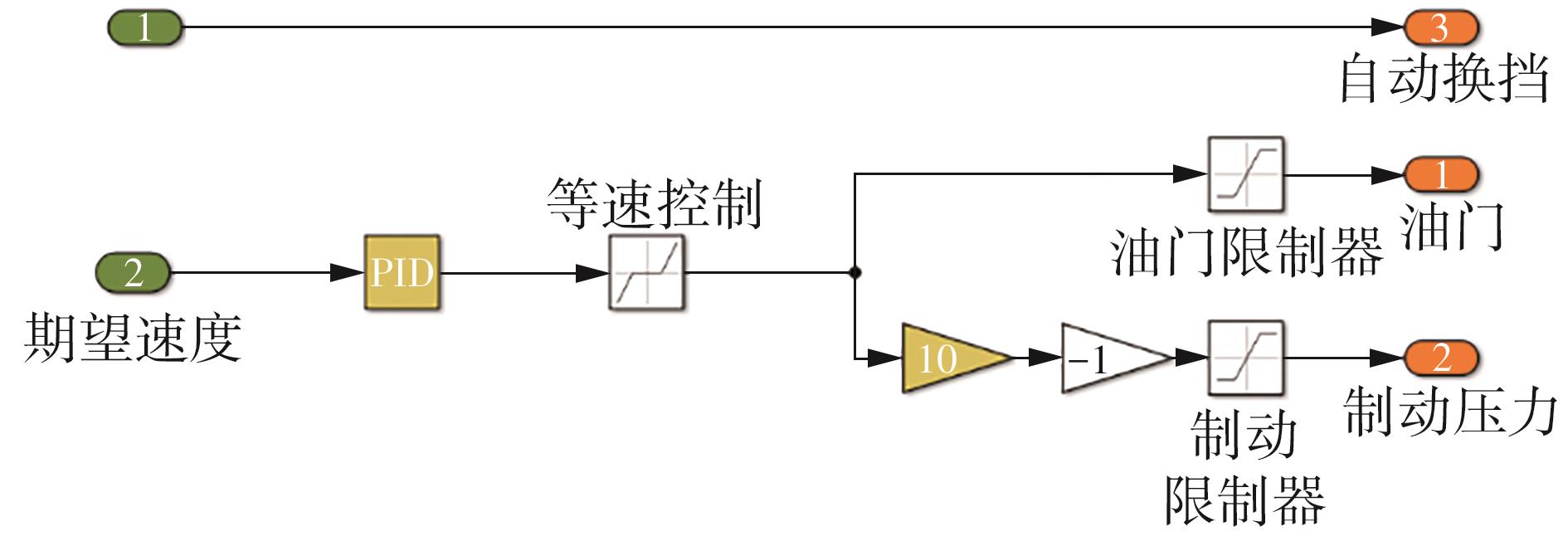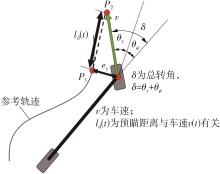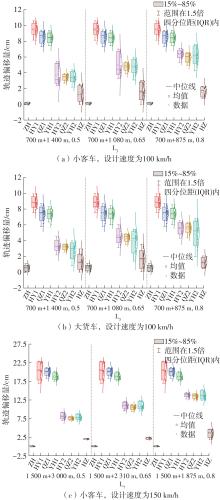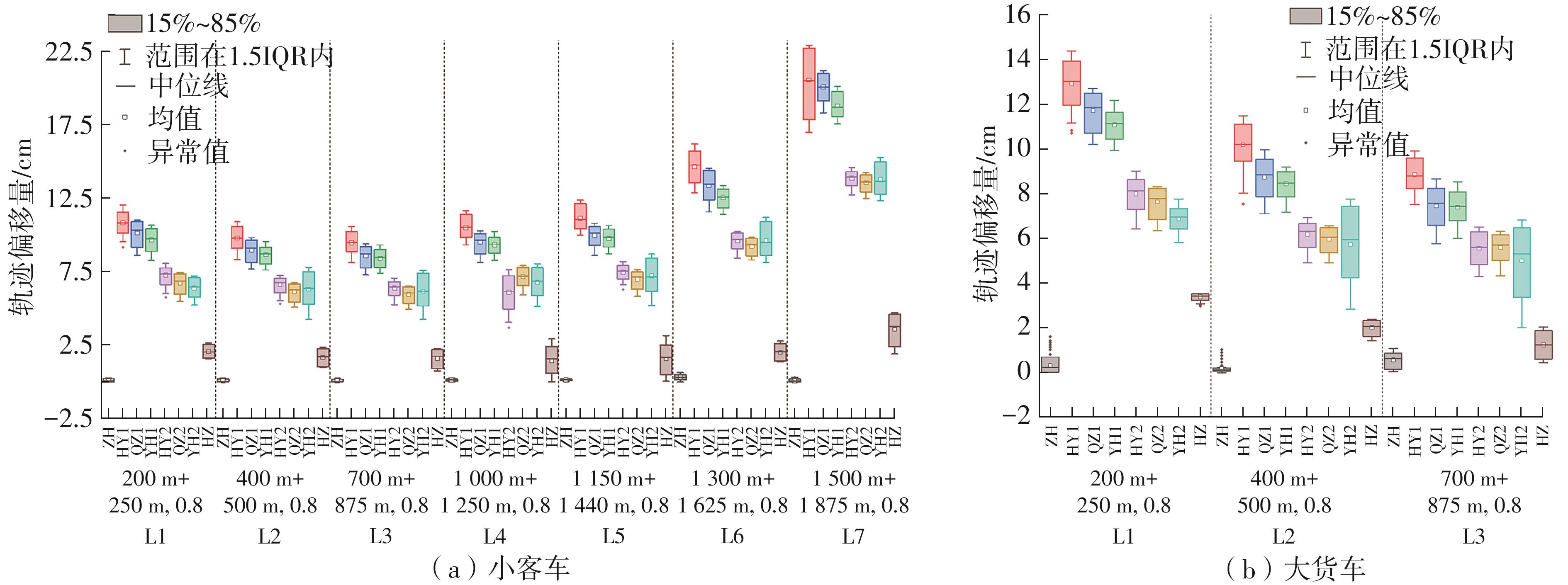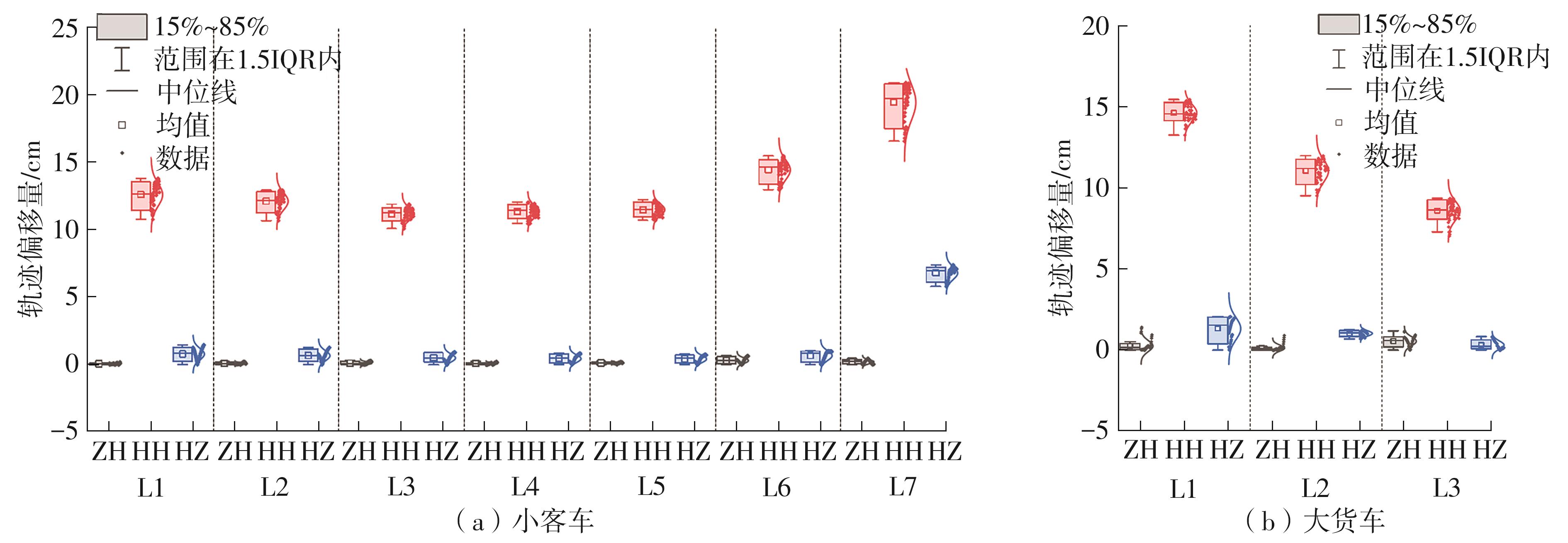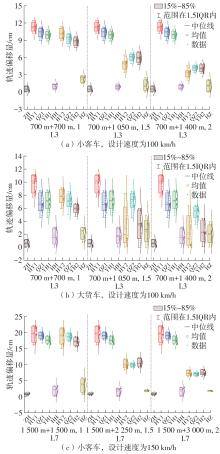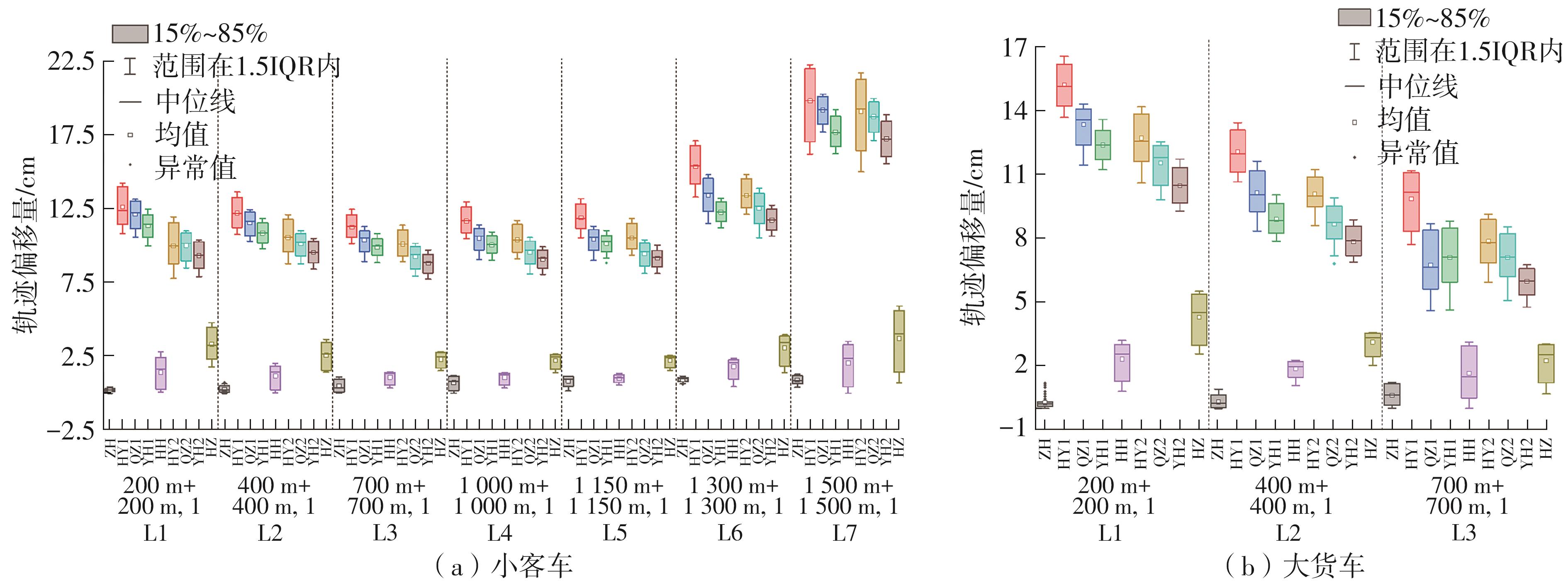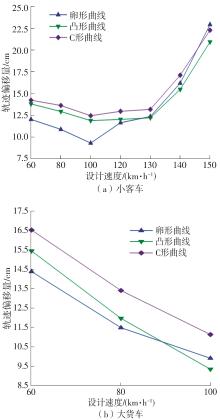Journal of South China University of Technology(Natural Science Edition) ›› 2025, Vol. 53 ›› Issue (7): 104-115.doi: 10.12141/j.issn.1000-565X.240590
• Traffic Safety • Previous Articles Next Articles
Effect of Complex Horizontal Alignment Combination Design on the Trajectory Offset of Autonomous Vehicles Based on PreScan
WANG Xiaofei1, HUANG Shiqi1, YAO Jiangbei2, ZENG Qiang1
- 1.School of Civil Engineering and Transportation,South China University of Technology,Guangzhou 510640,Guangdong,China
2.Guangdong Communication Planning & Design Institute Group Co. ,Ltd,Guangzhou 510635,Guangdong,China
-
Received:2024-12-20Online:2025-07-25Published:2025-03-07 -
Contact:曾强(1988—),男,博士,副教授,主要从事交通安全和交通组织研究。 E-mail:zengqiang@scut.edu.cn -
About author:王晓飞(1980—),女,博士,副教授,主要从事公路路线及交通安全研究。E-mail: xiaofeiw@scut.edu.cn -
Supported by:the National Natural Science Foundation of China(72471091);the Natural Science Foundation of Guangdong Province(2024A1515011177);the Science and Technology Plan Project of Guangdong Province(2024A1111120009)
CLC Number:
Cite this article
WANG Xiaofei, HUANG Shiqi, YAO Jiangbei, ZENG Qiang. Effect of Complex Horizontal Alignment Combination Design on the Trajectory Offset of Autonomous Vehicles Based on PreScan[J]. Journal of South China University of Technology(Natural Science Edition), 2025, 53(7): 104-115.
share this article
Table 1
Table of experimental designs for oval curve"
| 车型 | 设计标准 | 设计速度/(km·h-1) | 小圆曲线半径 | 小圆与大圆曲线半径比值 | 圆曲线长度/m | 缓和曲线长度/m |
|---|---|---|---|---|---|---|
| 小客车 | L1 | 60 | 200 | 0.5,0.65,0.8 | 100 | 75 |
| L2 | 80 | 400 | 0.5,0.65,0.8 | 130 | 100 | |
| L3 | 100 | 700 | 0.5,0.65,0.8 | 170 | 130 | |
| L4 | 120 | 1 000 | 0.5,0.65,0.8 | 200 | 150 | |
| L5 | 130 | 1 150 | 0.5,0.65,0.8 | 220 | 165 | |
| L6 | 140 | 1 300 | 0.5,0.65,0.8 | 235 | 180 | |
| L7 | 150 | 1 500 | 0.5,0.65,0.8 | 250 | 190 | |
| 大货车 | L1 | 60 | 200 | 0.5,0.65,0.8 | 100 | 75 |
| L2 | 80 | 400 | 0.5,0.65,0.8 | 130 | 100 | |
| L3 | 100 | 700 | 0.5,0.65,0.8 | 170 | 130 |
Table 3
Table of experimental designs for C-shape curve"
| 车型 | 设计标准 | 设计速度/(km·h-1) | 前圆曲线半径 | 后圆、前圆曲线半径比值 | 圆曲线长度/m | 缓和曲线长度/m |
|---|---|---|---|---|---|---|
| 小客车 | L1 | 60 | 200 | 1.0,1.5,2.0 | 100 | 75 |
| L2 | 80 | 400 | 1.0,1.5,2.0 | 130 | 100 | |
| L3 | 100 | 700 | 1.0,1.5,2.0 | 170 | 130 | |
| L4 | 120 | 1 000 | 1.0,1.5,2.0 | 200 | 150 | |
| L5 | 130 | 1 150 | 1.0,1.5,2.0 | 220 | 165 | |
| L6 | 140 | 1 300 | 1.0,1.5,2.0 | 235 | 180 | |
| L7 | 150 | 1 500 | 1.0,1.5,2.0 | 250 | 190 | |
| 大货车 | L1 | 60 | 200 | 1.0,1.5,2.0 | 100 | 75 |
| L2 | 80 | 400 | 1.0,1.5,2.0 | 130 | 100 | |
| L3 | 100 | 700 | 1.0,1.5,2.0 | 170 | 130 |
| [1] | 王之中,余荣杰,来飞,等 .国家自然科学基金委员会交通与运载工程学科2023年度管理工作综述[J].交通运输工程学报,2024,24(1):1-8. |
| WANG Zhizhong, YU Rongjie, LAI Fei,et al .Review on management of transportation and vehicle engineering discipline of NSFC in 2023[J].Journal of Tra-ffic and Transportation Engineering,2024,24(1):1-8. | |
| [2] | 李升波,刘畅,殷玉明,等 .汽车端到端自动驾驶系统的关键技术与发展趋势[J].人工智能,2023(5):1-16. |
| LI Shengbo, LIU Chang, YIN Yuming,et al .Key technologies and development trends of end-to-end automated driving systems for autonomous vehicles[J].Artificial Intelligence View,2023(5):1-16. | |
| [3] | 袁佩君 .自动驾驶汽车交通肇事的归责困境及刑法应对[J].华南理工大学学报(社会科学版),2023,25(2):30-40 |
| YUAN Peijun .The dilemma of attributing responsibility to traffic accidents caused by self-driving cars and the countermeasures of criminal law[J].Journal of South China University of Technology (Social Science Edition),2023,25(2):30-40 | |
| [4] | LIU Yuyan, TIGHT M, SUN Quanxin,et al .A systematic review:road infrastructure requirement for connected and autonomous vehicles (CAVs)[J].Journal of Physics:Conference Series,2019,1187(4):42-73. |
| [5] | 何永明,邢婉钰,魏堃,等 .超高速公路自动驾驶车辆换道轨迹规划策略[J].华南理工大学学报(自然科学版),2024,52(4):104-113 |
| HE Yongming, XING Wanyu, WEI Kun,et al .Lane-changing trajectory planning strategy for autonomous vehicles on superhighways[J].Journal of South China University of Technology (Natural Science Edition),2024,52(4):104-113. | |
| [6] | 徐进,陈钦,陈正委,等 .适应无人驾驶汽车的道路设施设计综述[J].西南交通大学学报,2023,58(6):1366-1377. |
| XU Jin, CHEN Qin, CHEN Zhengwei,et al .Review of roadway facility design for self-driving cars[J].Journal of Southwest Jiaotong University,2023,58(6):1366-1377. | |
| [7] | LIU Zhaocai, SONG Ziqi .Strategic planning of dedicated autonomous vehicle lanes and autonomous vehicle/toll lanes in transportation networks[J].Transportation Research Part C:Emerging Technologies,2019,10:381-403. |
| [8] | CHEN Zhibin, HE Fang, ZHANG Lihui,et al .Optimal deployment of autonomous vehicle lanes with endogenous market penetration[J].Transportation Research Part C:Emerging Technologies,2016,72:143-156. |
| [9] | LIU Hao, KAN Xingan, SHLADOVER S E,et al .Modeling impacts of cooperative adaptive cruise control on mixed traffic flow in multi-lane freeway facilities[J].Transportation Research Part C:Emerging Technologies,2018,95:261-279. |
| [10] | 姚志洪,郝慧君,巫雪梅,等 .考虑自动驾驶的混合交通流路段阻抗函数[J].交通运输工程与信息学报,2021,19(4):1-12. |
| YAO Zhihong, HAO Huijun, WU Xuemei,et al .Cost function of mixed traffic flow with autonomous driving[J].Journal of Transportation Engineering and Information,2021,19(4):1-12. | |
| [11] | 常鑫,李海舰,荣建,等 .混有网联车队的高速公路通行能力分析[J].华南理工大学学报(自然科学版),2020,48(4):142-148. |
| CHANG Xin, LI Haijian, RONG Jian,et al .Analysis of capacity for mixed traffic flow with connected vehicle platoon on freeway[J].Journal of South China University of Technology (Natural Science Edition),2020,48(4):142-148. | |
| [12] | 公路工程技术标准: [S]. |
| [13] | 公路路线设计规范: [S]. |
| [14] | OTHMAN K .Impact of autonomous vehicles on the physical infrastructure:changes and challenges[J].Designs,2021,5(3):40. |
| [15] | GARCÍA A, CAMACHO-TORREGROSA F J .Influence of lane width on semi- autonomous vehicle performance[J].Transportation Research Record,2020,2674(9):279-286. |
| [16] | HU Hongyu, GAO Zhenhai, YU Ziwen,et al .An experimental driving simulator study of unintentional lane departure[J].Advances In Mechanical Engineering,2017,9(10):1-8. |
| [17] | RAJU N, KUMAR P, JAIN A,et al .Application of trajectory data for investigating vehicle behavior in mixed traffic environment[J].Transportation Research Record,2018,2672(43):122-133. |
| [18] | GHASEMZADEH A, AHMED M M .Utilizing naturalistic driving data for in-depth analysis of driver lane-keeping behavior in rain:non-parametric MARS and parametric logistic regression modeling approaches[J].Transportation Research Part C-Emerging Technologies,2018,90:379-392. |
| [19] | CHANG Xin, LI Haijian, RONG Jian,et al .Determining the appropriate lane width at urban signalised intersections-a case study in Beijing[J].IET Intelligent Transport Systems,2019,13(12):1785-1791. |
| [20] | DING Rui, PAN Cunshu, DAI Zhenhua,et al .Lateral oscillation characteristics of vehicle trajectories on the straight sections of freeways[J].Applied Sciences,2022,12(22):11498. |
| [21] | 庄稼丰,李正军,丁瑞,等 .高速公路车辆轨迹摆动特征与小客车道宽度研究[J].交通运输系统工程与信息,2023,23(1):324-336. |
| ZHUANG Jiafeng, LI Zhengjun, DING Rui,et al .Vehicles trajectory oscillation characteristics and passenger cars’ lane width for freeways[J].Journal of Transportation Systems Engineering and Information Technology,2023,23(1):324-336. | |
| [22] | CAI Guoshun, XU Liwei, LIU Ying,et al .Robust preview path tracking control of autonomous vehicles under time-varying system delays and saturation[J].IEEE Transactions on Vehicular Technology,2023,72(7):8486-99. |
| [23] | WEIGEL H, LINDNER P, WANIELIK G .Vehicle tracking with lane assignment by camera and lidar sensor fusion[C]∥ Proceeding of the 2009 IEEE Intelligent Vehicles Symposium.Xi’an:IEEE,2009:513-520. |
| [24] | Hillel A BAR, LERNER R, LEVI D,et al .Recent progress in road and lane detection:a survey[J].Machine Vision and Applications 2014,25:727-745. |
| [25] | LIU Xin, XU Xin, DAI Bin .Vision-based long-distance lane perception and front vehicle location for full autonomous vehicles on highway roads[J].Journal of Central South University,2012,19(5):1454-1465. |
| [26] | LIU Ruijin, YUAN Zejian, LIU Tie, al et,End-to-end lane shape prediction with transformers[C]∥ Proceedings of the IEEE/CVF Winter Conference on Applications of Computer Vision.Waikoloa:IEEE,2021:3694-3702. |
| [27] | WANG Yue, TEOH E K, SHEN Dinggang .Lane detection and tracking using B-Snake[J].Image and Vision Computing,2004,22(4):269-280. |
| [28] | 赵祥模国家重点研发计划( 2021 YFB2501200)团队.自动驾驶测试与评价技术研究进展[J].交通运输工程学报,2023,23(6):10-77. |
| ZHAO Xiang mo’s Team Supported by the National Key Research and Development Program of China (2021 YFB2501200).Research progress in testing and evaluation technologies for autonomous driving[J].Journal of Traffic and Transportation Engineering,2023,23(6):10-77. | |
| [29] | 王晓飞,申天杰,郭月利,等 .基于PreScan的自动驾驶小客车弯坡段轨迹偏移研究[C]∥ 2024世界交通运输大会(WTC2024)论文集(公路工程).北京:人民交通出版社,2024:7. |
| [30] | 华南理工大学 .一种自动驾驶专用车道的高速公路横断面设计方法及系统:CN202410534960.X[P].2024-08-16. |
| [31] | 孙福昌,邵金菊,单少飞,等 .适应道路曲率多变的前馈-预测LQR横向控制[J].重庆理工大学学报(自然科学),2024,38(2):45-54. |
| SUN Fuchang, SHAO Jinju, SHAN Shaofei,et al .Feed-forward predictive LQR lateral control adapted to variable road curvature[J].Journal of Chongqing University of Technology (Natural Science),2024,38(2):45-54. | |
| [32] | 王文涛 .面向车道居中的转向驾驶权切换控制研究[D].长春:吉林大学,2023. |
| [33] | 贾立新,林秀锐,倪洪杰,等 .基于紧约束鲁棒模型预测控制的无人车辆轨迹跟踪控制[J].高技术通讯,2024,34(3):275-281. |
| JIA Lixin, LIN Xiurui, NI Hongjie,et al .Trajectory tracking control of unmanned vehicles based on tight constrained robust model predictive control[J].Chinese High Technology Letters,2024,34(3):275-281. | |
| [34] | 李学慧,苏振,张俊友 .多参数优化MPC的自动驾驶轨迹跟踪控制[J].重庆理工大学学报(自然科学),2024,38(2):55-64. |
| LI Xuehui, SU Zhen, ZHANG Junyou .Research on autonomous driving trajectory tracking control by multi-parameter optimization MPC[J].Journal of Chongqing University of Technology (Natural Science),2024,38(2):55-64. |
| [1] | . A Study on the Impact Mechanism of Human-Machine Mixed DrivingTraffic Flow Under Occasional Accident [J]. Journal of South China University of Technology(Natural Science Edition), 2025, 53(8): 61-72. |
| [2] | ZHONG Shaopeng, LIU Ao, ZHAI Junnuo, FAN Meihan, LI Xiyao, LIN Yuan, LI Zhenhua. Review of Multi-Level Urban Impacts of Shared Autonomous Vehicles [J]. Journal of South China University of Technology(Natural Science Edition), 2025, 53(6): 104-118. |
| [3] | ZHANG Chi, GUO Tingyu, HU Ruilai, GAO Yanyang, ZHOU Yuming. Research on Average Longitudinal Slope Length of Expressway Based on Braking Behavior [J]. Journal of South China University of Technology(Natural Science Edition), 2025, 53(2): 12-26. |
| [4] | ZHANG Yandi, HUI Bing, MA Ziye, LI Yuanle, WANG Hainian. Quantitative Method of Aggregate Spalling Degree of Chip Seal in Three Dimension [J]. Journal of South China University of Technology(Natural Science Edition), 2025, 53(2): 80-91. |
| [5] | ZHU Yu, XU Zhigang, ZHAO Xiangmo, et al. TsGAN-Based Automatic Generation Algorithm of Lane-Change Cut-in Test Scenarios on Expressways for Autonomous Vehicles [J]. Journal of South China University of Technology(Natural Science Edition), 2024, 52(8): 76-88. |
| [6] | CAO Ningbo, ZHAO Liying. Management Method of Autonomous Vehicles and Pedestrians at Intersections Based on Maximum Pressure Controls [J]. Journal of South China University of Technology(Natural Science Edition), 2024, 52(2): 124-135. |
| [7] | ZHENG Zhi, GUO Naisheng, YOU Zhanping. Molecular Simulation of Interaction Behavior Between Asphalt Components and Waste Wood Oil [J]. Journal of South China University of Technology(Natural Science Edition), 2024, 52(12): 79-86. |
| [8] | WANG Wei, TAN Yiqiu, XU Yongjiang. Study on Internal Stress of Asphalt Mixture Under Three-Point Bending Mode [J]. Journal of South China University of Technology(Natural Science Edition), 2024, 52(10): 101-111. |
| [9] | LI Baijian, HUANG Yan, FU Xinsha. Influence of Shapes of Corrugated Steel Plate on Load-Carrying Capacity of Reinforced Concrete Slab Culvert and Arch Effect with Lateral Restraint [J]. Journal of South China University of Technology(Natural Science Edition), 2024, 52(1): 110-118. |
| [10] | MAO Xuesong, WANG Yueyue, WU Qian, et al. Structure Evolution Law of Soil-Rock Mixture Fillers with Different Gradations Under Seepage [J]. Journal of South China University of Technology(Natural Science Edition), 2023, 51(2): 65-75. |
| [11] | YU Bin, ZHANG Yuqin, WANG Yuchen, et al. Automated Extraction of Road Geometry Information Using Mobile LiDAR Point Cloud [J]. Journal of South China University of Technology(Natural Science Edition), 2023, 51(2): 88-99. |
| [12] | ZHANG Chi, REN Shipeng, WANG Bo, et al. Speed Characteristics and Prediction of Trucks on Long and Steep Downgrade Sections [J]. Journal of South China University of Technology(Natural Science Edition), 2022, 50(3): 38-49. |
| [13] | CHEN Jiqing, SHU Xiaoxiong, LAN Fengchong, et al. Construction of Autonomous Vehicles Test Scenarios with Typical Dangerous Accident Characteristics [J]. Journal of South China University of Technology (Natural Science Edition), 2021, 49(5): 1-8. |
| [14] | FU Guozhi, WEI Jincheng, ZHAO Yanqing, et al. Influence of Asphalt Pavements' Dynamic Effects on the Surface Acceptance Deflection [J]. Journal of South China University of Technology (Natural Science Edition), 2021, 49(4): 90-96. |
| [15] | AI Changfa, HUANG Yangquan, LUO Liufen, et al. Estimation of Comprehensive Impact of External Factors on Interlayer Fatigue Life of Asphalt Pavement Based on ISS & SSDR [J]. Journal of South China University of Technology (Natural Science Edition), 2020, 48(5): 58-66,74. |
| Viewed | ||||||
|
Full text |
|
|||||
|
Abstract |
|
|||||
